2015 Corn Disease Management Update
DR. TREY PRICE AND DR. CLAYTON HOLLIER
WINNSBORO, LA. AND BATON ROUGE, LA.
An important consideration when planting corn is the choice of fungicide seed treatment. There are many commercially available seed treatments from which to choose. If planting on the early side of the recommended planting window with less-than ideal weather conditions (cool, wet), a fungicide seed treatment containing three modes of action may be warranted. A seed treatment containing the group 4 fungicides, metalaxyl or mefenoxam (or others), with activity on Pythium, Phytophthora, and other species can protect corn seedlings when rainy conditions prevail. Several hotspots of Pythium were noted in seedling corn during the 2014 season, and the same areas within fields tend to be affected from year to year (Photos 1 & 2). An addition of a group 3, M, 11, or 12 fungicide to the treatment may be necessary to manage other seedling pathogens such as: Fusarium, Rhizoctonia, and others. In problem areas in-furrow applications of fungicides at planting may be effective as well. If planting on the latter side of the recommended planting window with ideal weather conditions prevailing, a base seed treatment should be adequate for seedling disease management and may reduce production costs.
Foliar Disease Concerns
Fungicides should not be applied to corn in the absence of disease. Results from many years of research conducted at multiple locations in Louisiana since 2006 do not indicate that fungicides provide yield benefits to corn if diseases are not present. Blanket applications of fungicides to corn may impose a selection pressure to low level pathogen populations resulting in fungicide resistance. Additionally, with lowered commodity prices, cutting out an unnecessary fungicide application may reduce costs.
Cornfields should be thoroughly scouted throughout the growing season for potentially damaging foliar diseases. Many factors must be considered including: the specific pathogen causing the problem (What are we dealing with?), disease incidence and severity (How bad is it?), crop maturity (How far-along is the corn?), prevailing environmental conditions (How’s the weather?), efficacy (Will it work?), and economics (Will there be a return on the investment?). When disease epidemics are progressing in young corn (tasseling to blister) and prevailing environmental conditions are conducive for disease development, a fungicide may be needed to slow epidemics and protect yield and quality. Make application decisions on a field-by-field basis. There are many labeled products with broad spectrum activity available for corn. Please refer to the Plant Disease Management Guide available at www.lsuagcenter.com for more information.
Foliar Diseases of Corn Common to Louisiana
Common rust, caused by Puccinia sorghi, is a fungal disease usually found every year in Louisiana but rarely causes yield losses. Initial infections occur after spores are blown in from corn-producing areas in tropical and sub-tropical regions of the world. This disease may be evident early in the growing season prior to tasseling, and usually is the first disease present in Louisiana corn. Pustules are elongated, ragged looking, and occur on the upper and lower leaf surfaces (Photo 3). Spores within pustules are cinnamon-brown in color, and in some cases occur in bands because of infections that occurred while the leaf was in the whorl. Conditions that favor development are 60 to 77°F with at least 6 hours of leaf wetness and high relative humidity. Disease development of common rust will usually subside when temperatures exceed 77°F.
Southern rust, caused by the fungus Puccinia polysora, may also be present in Louisiana corn, and may develop to damaging levels if infection occurs early (prior to tasseling). Similar to common rust, initial infections are caused by wind-blown spores. This is a warmer-season rust compared to common rust and usually occurs late season and does not have adequate time to impact yield. Southern rust produces small circular to oval pustules and contain orange to light brown spores lighter in color compared to common rust (Photo 4). Pustules are usually smaller and less ragged than common rust, and are more abundant on the upper leaf surface. Pustules also may be found on the leaf sheath when disease is severe. Conditions favoring development are 80 to 90°F with extended periods of high relative humidity or abundant rainfall.
Southern rust was prevalent in late-planted corn in 2014, and in situations where infection occurred from tasseling to blister, fungicide applications preserved yield.
Northern corn leaf blight is caused by the fungus, Exserohilum turcicum, and was present at damaging levels in some fields during 2010 and a minor problem in 2014. The disease may be found in Louisiana cornfields during mid-season (tasseling/flowering) and may cause yield loss in some cases. Lesions of northern corn leaf blight usually begin in the lower canopy and progress upward. Lesions begin as small elliptical or spindle shaped lesions, and mature lesions may be six inches in length and about ½ to 1 inch wide (Photo 5). The lesions are grayish green in color. The fungus may survive on infected corn debris left on the soil surface from the previous growing season. Therefore, the risk of this disease increases in fields where reduced-tillage practices are used and corn is planted continuously. Corn debris from the previous season provides inoculum for disease initiation and establishment. Spores produced on this debris are disseminated by wind and rain splash infecting the current crop, and subsequent infection results from spores produced within lesions. There are several races of this pathogen; therefore, the effectiveness of genetic resistance may vary depending on the races present in a particular field. Conditions favoring development are 60 to 90°F with 6-18 hours of leaf wetness and high relative humidity. ∆
DR. TREY PRICE: Assistant Professor, LSU AgCenter
DR. CLAYTON HOLLIER: Professor, Department of Plant Pathology, LSU AgCenter
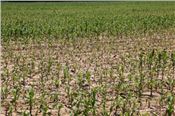
Photo 1. Thinned stand as a result of Pythium infections.
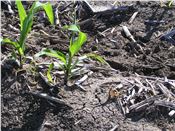
Photo 2. A dead corn seedling (right) as a result of Pythium infection.
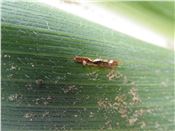
Photo 3. Foliar symptoms of common rust.
Photo Courtesy of Boyd Padgett
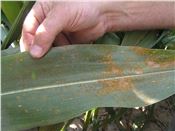
Photo 4. Foliar symptoms of southern rust.
Photo Courtesy of Boyd Padgett
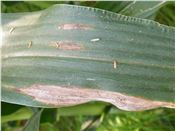
Photo 5. Foliar symptoms of northern corn leaf blight
(Photo Courtesy of Boyd Padgett)